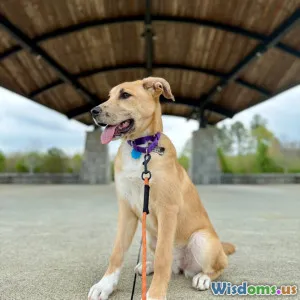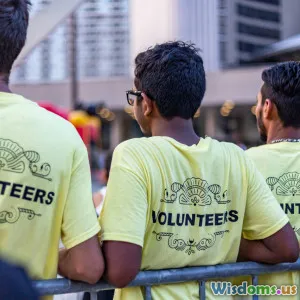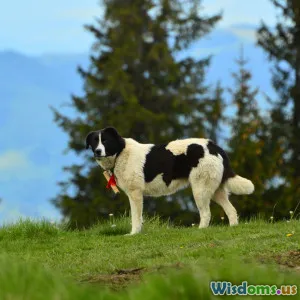
From Couch to Agility Star Training Older Dogs for New Challenges
6 min read Discover how to transform your older dog into an agility star through tailored training, fostering mental and physical vitality. (0 Reviews)
From Couch to Agility Star: Training Older Dogs for New Challenges
As our furry companions mature, every wrinkle and gray hair tells a story of loyal companionship. Yet, many dog owners believe that agility and physical challenges are reserved solely for puppies or young adults. What if we could change this narrative? Training older dogs in agility not only breathes new life into their routine but enhances their overall well-being, mental stimulation, and strengthens the human-animal bond.
Embracing the Possibility: Why Older Dogs Can Excel in Agility
It's a common misconception that agility is only for young, hyperactive dogs. However, agility training is adaptable to any age and breed, scaling exercises to suit an older dog's physical capacity and personality.
Veterinarians and behaviorists alike emphasize the importance of continued mental and physical activity in senior dogs. Dr. Jennifer Coates, a veterinary advisor well-versed in canine fitness, states, "Engaging older dogs in structured physical activity like agility helps maintain joint flexibility, muscle tone, and cognitive function, reducing risks of age-related decline."
Scientific Backing
A 2019 study published in the Journal of Veterinary Behavior demonstrated that mental and physical training can slow cognitive decline in aging dogs, akin to how regular exercise benefits aging humans. Participating in activities such as agility provides both high-level mental engagement and heart health benefits.
Getting Started: Assessing Your Dog's Readiness
Before jumping into agility training, a thorough health assessment and understanding of your dog's personality are crucial.
Veterinary Clearance
Consult your veterinarian to assess joint health, cardiac function, and overall mobility. Conditions like arthritis or heart disease don't automatically rule out agility but may require modifications.
Personality and Enthusiasm
Observe your dog's willingness to engage. Some seniors relish new experiences, while others may prefer gentler activities. Do patience and encouragement guide the approach.
Tailoring Agility Training for Seniors
Start Slow and Simplify
Traditional agility courses can be physically demanding. Adjusting the course by lowering obstacles, increasing rest time, and introducing familiar commands eases transition.
For example, instead of standard jumps, start with low hurdles or pole weaves with ample hand guidance.
Focus on Fun and Confidence Building
Positive reinforcement with treats and verbal praise helps build excitement and confidence. The goal is not competitive speed but safe and joyful participation.
Incorporate Physical Therapy Elements
Combine agility with gentle exercises such as balance boards, low-impact tunnels, or cavaletti poles designed to enhance proprioception and reduce stiffness.
Real-World Success Stories
Case Study: Bella the Beagle
Bella, an 8-year-old beagle rescued from a shelter, was lethargic and overweight. Her owner began a modified agility regimen focusing on low-impact tunnels and weave poles adapted for her size. Within months, Bella showed improved stamina, weight loss, and brighter engagement with her environment.
Senior Dog Agility Clubs
Clubs and classes nationwide are adopting senior-friendly agility sessions. These specialized classes foster community among owners and offer expert-led socialization and skill advancement.
Benefits Beyond the Course
- Physical Health: Improved cardiovascular fitness, muscle tone, and joint flexibility.
- Cognitive Stimulation: Learning new commands and navigating obstacles keeps the brain active.
- Emotional Well-being: Overcoming challenges increases confidence and reduces anxiety.
- Bonding: Shared activities enhance trust and deepen the human-dog relationship.
Overcoming Challenges
Handling Physical Limitations
Adapt training to your dog’s pace. Use softer surfaces to cushion joints and watch for signs of fatigue or discomfort.
Patience Is Key
Older dogs may take longer to learn new tasks. Celebrate small victories and maintain consistency.
Expert Tips for Success
- Regular Vet Check-ups: Monitor health throughout the training process.
- Warm-Up and Cool-Down: Gentle walking or stretching reduces injury risk.
- Hydrate: Keep water accessible to avoid dehydration.
- Use Motivators: Tailor rewards to your dog’s favorite treats or toys.
- Keep Sessions Short: Short, frequent sessions prevent exhaustion and boredom.
Conclusion: Lifelong Learners
Age does not define the limits of what our canine companions can achieve. With thoughtful adjustments, older dogs can flourish through agility training, gaining physical health, mental stimulation, and happiness. Whether your dog is ten or fifteen, it's never too late to embark on a journey from couch to agility star—unlock your senior dog’s hidden potential and enrich their golden years with fresh, rewarding challenges.
Embrace the adventure. Celebrate your older dog’s potential to inspire.
Rate the Post
User Reviews
Other posts in Animal Training & Obedience
Popular Posts


















